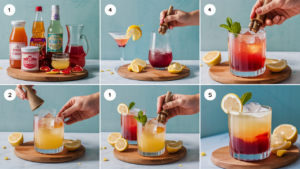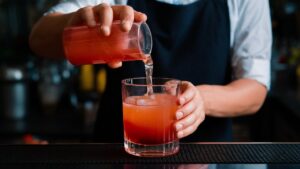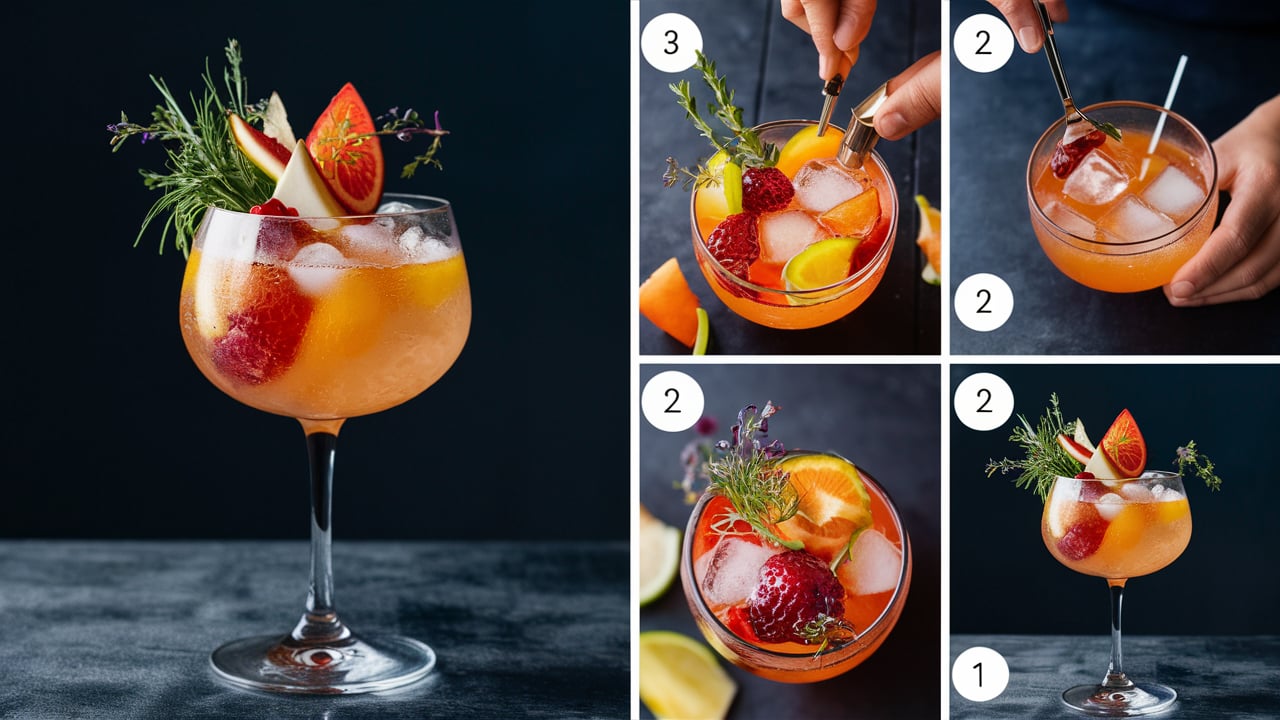Creating Non-Alcoholic Cocktails: A Complete Guide
Creating non-alcoholic cocktails, often referred to as mocktails, has become a popular trend. With the rise of health-conscious living and an increasing focus on wellness, many people are turning to alcohol-free options for their drinks. Whether you’re hosting a gathering, preparing for a special occasion, or simply looking for a way to enjoy a flavorful beverage without the alcohol, mocktails offer the perfect solution. In this guide, we’ll cover everything you need to know about how to make a cocktail without alcohol, from selecting the right ingredients to perfecting the art of presentation.
Part 1: Introduction to Non-Alcoholic Cocktails
Why Choose Non-Alcoholic Cocktails?
Before diving into the recipes, it’s essential to understand why non-alcoholic cocktails are worth your time. There are many reasons to opt for a mocktail:
- Health Benefits: Alcoholic beverages are often high in calories, sugar, and alcohol, which can affect your liver, heart, and overall well-being. By choosing mocktails, you avoid these risks while still enjoying delicious, creative drinks.
- Social Inclusivity: Not everyone drinks alcohol. Whether for religious, health, or personal reasons, offering non-alcoholic cocktails at gatherings ensures that everyone feels included. According to Healthline, using fresh fruit juices can enhance the flavor profile of your mocktails.
- Refreshing and Creative: Non-alcoholic cocktails allow for a wide range of flavors and creativity. You can experiment with fresh herbs, fruits, and mixers without being limited by alcohol. Explore some creative mocktail ideas for inspiration.
Part 2: Essential Ingredients for Non-Alcoholic Cocktails

When making a cocktail without alcohol, the key is to focus on high-quality, flavorful ingredients. Here are some of the essentials:
- Fruits and Juices: Fruits are a cornerstone of many non-alcoholic cocktails. Citrus fruits like lemons, limes, and oranges provide a zesty punch, while berries, pineapples, and apples add natural sweetness and color. Freshly squeezed juices are always preferable to store-bought versions, as they pack more flavor and fewer preservatives.
- Herbs and Spices: Herbs like mint, basil, and rosemary add depth and complexity to mocktails. They can be muddled to release their oils or used as garnishes to elevate the presentation. Spices such as cinnamon, ginger, and cardamom can add warmth and a unique twist to your drinks.
- Syrups and Sweeteners: A touch of sweetness can balance out the tartness of certain fruits or the bitterness of herbs. Simple syrup (made from equal parts sugar and water) is a versatile option, but you can also experiment with honey, agave nectar, or flavored syrups like grenadine.
- Sparkling Water and Sodas: To give your non-alcoholic cocktails a bubbly, effervescent quality, add sparkling water or soda. These can also be flavored for an extra layer of complexity. For example, tonic water adds a slight bitterness that can mimic the taste of certain alcoholic spirits.
- Teas and Infusions: Teas, whether black, green, or herbal, can serve as a flavorful base for mocktails. Infused water (flavored with cucumbers, berries, or citrus) also adds a refreshing twist without overpowering the other ingredients. Learn more about the benefits of using herbs in beverages.
Part 3: Tools You Need to Make the Perfect Mocktail
Making a cocktail without alcohol requires some basic bar tools. Here’s what you should have on hand:
- Cocktail Shaker: Essential for mixing ingredients thoroughly and chilling the drink.
- Muddler: Used for crushing herbs, fruits, and spices to release their flavors.
- Jigger: A small measuring tool that ensures the perfect balance of ingredients.
- Strainer: Helps separate the liquid from any muddled ingredients or ice.
- Mixing Spoon: A long spoon for stirring drinks that don’t require shaking.
Part 4: Step-by-Step Guide to Crafting the Perfect Mocktail
Now that you have your ingredients and tools ready, let’s get into the process of creating your mocktail.
- Choose Your Base Start by selecting your base ingredient, which can be fruit juice, tea, or infused water. This will form the foundation of your drink. For example, if you’re making a citrus mocktail, fresh lemon or orange juice can be your base.
- Add Flavors Next, layer in your flavors. This could be in the form of fresh herbs, spices, or additional fruit juices. If you’re making a mock mojito, for instance, you would add fresh mint leaves and lime juice at this stage.
- Sweeten to Taste Adjust the sweetness of your drink by adding simple syrup, honey, or any other sweetener. Start with a small amount and taste as you go, ensuring that the drink isn’t too sugary.
- Incorporate Bubbles If your mocktail calls for it, now is the time to add sparkling water or soda. Pour slowly to avoid losing too much of the carbonation.
- Shake or Stir Depending on the ingredients, either shake your mocktail in a cocktail shaker with ice or stir it in a mixing glass. Shaking is ideal for drinks that include fruit juices or thicker syrups, while stirring works well for lighter, clearer beverages.
- Strain and Serve Once your drink is mixed, strain it into your glass of choice. If you prefer your drink over ice, fill the glass with ice cubes first.
- Garnish Finally, garnish your mocktail with a slice of fruit, a sprig of herbs, or even edible flowers. Presentation is key, and garnishes make your drink look as good as it tastes.
Part 5: Popular Non-Alcoholic Cocktail Recipes

Here are a few classic non-alcoholic cocktail recipes to get you started. These are easy to make and perfect for any occasion.
- Virgin Mojito
- Ingredients: Fresh mint leaves, lime juice, simple syrup, soda water, crushed ice.
- Instructions: Muddle the mint leaves with lime juice and simple syrup in a glass. Add crushed ice, top with soda water, and stir. Garnish with a lime wheel and a sprig of mint.
- Nojito
- Ingredients: Lime, mint, sugar, soda water.
- Instructions: Muddle mint leaves and sugar, squeeze in lime juice, add ice, and top with soda water.
- Cucumber Cooler
- Ingredients: Cucumber slices, lime juice, mint leaves, soda water.
- Instructions: Muddle cucumber slices and mint leaves, add lime juice, top with soda water, and serve over ice.
- Fruit Punch
- Ingredients: Orange juice, pineapple juice, grenadine, soda water.
- Instructions: Mix the juices with grenadine, add soda water, and serve over ice.
Part 6: Pairing Mocktails with Food
When serving mocktails, it’s essential to consider the food pairings. Here are a few suggestions for pairing your non-alcoholic cocktails with meals:
- Citrus Mocktails: These pair well with light and fresh foods like salads, grilled chicken, and seafood. The acidity of citrus helps cut through the richness of these dishes, making for a refreshing pairing.
- Herbal Mocktails: Drinks with fresh herbs like mint or basil complement Mediterranean dishes, such as grilled vegetables, hummus, and flatbreads. The herbal notes in the drink enhance the flavors of these dishes.
- Sweet Mocktails: For a sweeter mocktail, like a fruit punch or a berry-based drink, consider pairing with desserts like fruit tarts, cheesecake, or even chocolate treats. The sweetness of the drink will harmonize with the dessert, making for a delightful end to the meal.
Part 7: Health Benefits of Non-Alcoholic Cocktails
Non-alcoholic cocktails are more than just tasty; they can also be good for your health. Here are some of the benefits:
- Lower Calories: Without the added calories from alcohol, mocktails are often a lighter option. You can further reduce the calorie count by using natural sweeteners and fresh ingredients.
- Hydration: Many mocktails are made with hydrating ingredients like water, sparkling water, and juice. This can help you stay hydrated, especially in warmer weather.
- Nutrient-Rich: By using fresh fruits and vegetables, you’re incorporating vitamins and minerals into your drink. For example, citrus fruits are rich in vitamin C, and herbs like mint and basil contain antioxidants.

Part 8: FAQs
- What’s the Difference Between a Cocktail and a Mocktail?
- A cocktail contains alcohol, while a mocktail is a non-alcoholic version of the drink. Mocktails replicate the flavors of traditional cocktails but use substitutes like fruit juices, soda water, and herbs instead of spirits.
- Can I Make Mocktails Ahead of Time?
- Yes, you can prepare some mocktails in advance, but it’s best to add any sparkling components (like soda water) right before serving to maintain the fizz. Store the base mix in the refrigerator and combine with bubbles when ready to serve.
- How Can I Make My Mocktail Healthier?
- To make a healthier mocktail, focus on fresh, whole ingredients. Use freshly squeezed juices instead of bottled ones, natural sweeteners like honey or agave, and limit the use of sugary syrups. Incorporating fresh herbs and vegetables can also add nutritional value.
- What Are Some Good Alternatives to Soda Water?
- If you want to avoid soda water, consider using coconut water, herbal teas, or flavored water as a base. These alternatives add flavor and can be more hydrating than traditional sodas.
- Can Mocktails Be Served at Formal Events?
- Absolutely! Mocktails can be just as elegant as traditional cocktails, especially when served in stylish glassware and garnished with fresh fruits or herbs. They are perfect for events where alcohol is not preferred, such as baby showers, corporate gatherings, or family celebrations.
Conclusion
Learning how to make a cocktail without alcohol is not only a fun and creative process, but it also opens up a world of possibilities for healthier, more inclusive beverage options. Whether you’re crafting a mocktail for a special occasion or just experimenting with new flavors at home, the key is to focus on fresh ingredients, balanced flavors, and beautiful presentation. With the tips and recipes shared in this guide, you can elevate your non-alcoholic drink game and impress your guests with delicious and refreshing mocktails.
Mocktails are a growing trend, and for good reason. They offer all the complexity and enjoyment of a traditional cocktail without the potential downsides of alcohol. Plus, they’re an excellent way to include everyone in the celebration, regardless of their drinking preferences. Cheers to your next alcohol-free adventure in mixology!

